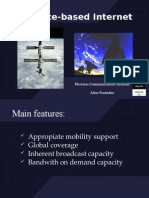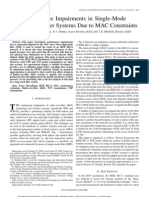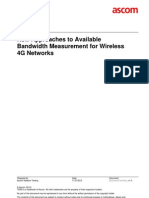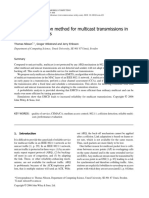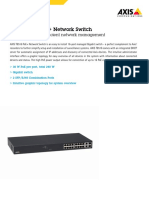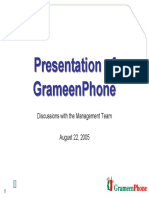Quality of Service in TDMA VSAT
Quality of Service in TDMA VSAT
Uploaded by
kidusCopyright:
Available Formats
Quality of Service in TDMA VSAT
Quality of Service in TDMA VSAT
Uploaded by
kidusOriginal Description:
Copyright
Available Formats
Share this document
Did you find this document useful?
Is this content inappropriate?
Copyright:
Available Formats
Quality of Service in TDMA VSAT
Quality of Service in TDMA VSAT
Uploaded by
kidusCopyright:
Available Formats
QoS over Demand-assigned TDMA Satellite Network
Mr. Srinivasan Sukumar
Mr. Loh Yeow Meng
Mr. Rusmin, Teddy
Mr. Pang Yoke Kum
School of Engineering
Temasek Polytechnic,
Singapore
Associate Professor
Krishnappa R Subramanian
Division of Communication
Engineering
Nanyang Technological
University, Singapore
Abstract
Demand-assigned Time Division Multiple Access
(DA-TDMA) is a type of satellite access technology
that is superior compared to Frequency Division
Multiple Access (FDMA) or Single Channel Per
Carrier (SCPC) in terms of efficiency in satellite
bandwidth usage.
In DA-TDMA, satellite bandwidth is shared among
the users at different sites based on allocation of
time slots rather than frequency. Hence, all the
earth stations of a DA-TDMA -based network will
transmit at the same frequency, but not at the same
time. In a DA-TDMA -based network, each earth
station is usually allocated a fixed percentage of
satellite bandwidth (time slots). Besides, there is a
certain percentage of satellite bandwidth, which can
be dynamically allocated to the earth stations,
basing on users demands. As a result, higher
efficiency in the use of satellite bandwidth can be
achieved. Due to their capability to dynamically
allocate satellite bandwidth based on demand, DATDMA -based satellite networks are more suitable to
carry bursty traffic than FDMA or SCPC-based
satellite networks.
The efficiency of such satellite bandwidth usage is
achieved at the expense of timing delay. This is
particularly so, as the traffic is using dynamically
assigned satellite bandwidth that imposes a certain
amount of delay. Such delay is proportional to the
propagation delay of a typical satellite link. Hence,
it is important to investigate the effects of providing
Quality of Service (QoS) over a DA-TDMA -based
satellite network.
This article proposes a Very Small Aperture
Terminal (VSAT) satellite network architecture with
DA-TDMA access to a C-Band satellite transponder
that aims to provide Quality of Service for different
services. The space segment of this DA-TDMA based satellite network comprises a geostationary
satellite, with the ground segment based on IPv4
and the Next Generation Internet Protocols, IPv6.
1. Introduction
In a Star Shaped Demand Assigned TDMA (DATDMA) Inbound / TDM Outbound Satellite
Dr. H.S. Cheng
Laboratories for
Information Technology
Agency for Science,
Technology and Research,
Singapore
Network (c.f. Figure 1), we can allocate K time slots
within a TDMA frame duration, to be shared by N
VSATs at the satellite inbound transponder band.
Every remote VSAT transmits its carrier burst at the
same bandwidth and same frequency, but is not preassigned to transmit its carrier burst within a
specific time slot (that is the position and duration
are not fixed). Any passive remote VSAT can
request to setup a satellite link (by turning from
carrier off state to carrier on state) with the hub
VSAT, and access any unoccupied time slot on the
TDMA frame duration. Any active remote VSAT
can also request the Hubs Network Management
System to increase its capacity by extending the
TDMA duration of its burst, to support a larger
number of connections.
When all the time slots on the TDMA frame
duration are being filled with carrier bursts (due to
more traffic demand from remote VSATs), blocking
of satellite link set-up may occur.
Figure 1: A Star Shaped Demand Assigned TDMA
(DA-TDMA) Inbound / TDM Outbound Satellite
Network
2. Issues in Implementation of DA-TDMA over
Satellite Links
There are three major resources which are available
to a satellite communication engineer. They are
power, bandwidth and time.
In demand-assigned TDMA technology, the satellite
engineer achieves gains in bandwidth through more
efficient use of satellite bandwidth but at the
expense of timing delay. This delay have an impact
of the QoS on the various applications in which the
demand-assigned TDMA-based satellite network is
supporting. This project examines several issues of
using demand-assigned TDMA technology to
interconnect geographically dispersed networks.
These issues can be classified into timing-related
and channel errors related issues.
There are several timing-related issues involved in
providing QoS over demand-assigned TDMA-based
satellite networks. The first issue is an increase in
burstiness of the traffic of any particular source.
With real time traffic, an increase in burstiness has
the greatest impact on the QoS. The main reason for
this is because several earth stations share the same
satellite channel and only one earth station is
allowed to transmit or "burst" at any one time. The
problem can be further aggravated by the less
predictable nature of satellite bandwidth allocation
compared to pure TDMA technology where the
allocation of satellite bandwidth to each earth
station is predetermined. In addition, if a
transmitting source (at the application level)
requests additional satellite bandwidth to be
allocated dynamically, there will be an additional
delay of twice the propagation delay of the satellite
link as the additional time is required for requests to
be made to the demand-assigned TDMA satellite
modem that is assigning the satellite bandwidth, and
also for the bandwidth to be assigned. Such requests
will significantly increases the burstiness of the
traffic.
Figure 2: Proposed Star Shaped DA-TDMA
Satellite Network
5. Phase 1 - DA-TDMA Infrastructure
Construction
The project is currently at Phase 1. Thus far, the
following infrastructure construction has been
completed at Temasek Polytechnic.
The second issue is the impact of the significantly
increased delay on the performance of transport
protocols, which require feedback mechanisms, for
flow control.
The third issue is the actual implementation of QoS,
which uses commercial-off-the-shelf (COTS)
products, over demand-assigned TDMA-based
satellite networks.
3. Main Considerations in Implementing a DATDMA Satellite Network
1) Satellite bandwidth required to support a wide
range of services [1].
2) Choice of satellite modem.
3) A sufficient energy-per-bit-to-noise density ratio
(Eb/No).
4) Internet Protocol used. (IPv4 and IPv6)
4. The Project
The project was consists of two phases. Phase 1
involves the Infrastructure Construction. Phase 2
involves the Network Performance Measurement.
Ethernet (VLAN1)
Ethernet (VLAN17)
Ethernet (VLAN18)
Ethernet (VLAN19)
RF IN (at Hub)
RF IN (at Remotes)
RF OUT (at Hub)
RF OUT (at Reotes)
Figure 3: A DA-TDMA Satellite Loopback
Network at Temasek Polytechnic
A satellite uplink test was successfully conducted.
The DA-TDMA Satellite Loopback Network
consists of the following:
Outdoor units
1) Two 2.4m VSAT dishes.
2) Two Radio Frequency Transceivers
(RFTs).
3) Two Solid-state Power Amplifiers
(SSPAs).
4) Two feedhorns.
Indoor units
1) Five satellite modems.
2) A Network Management System.
3) A Cisco switch.
4) A video conferencing server and video
conferencing clients.
6. Phase 2 Network Performance Measurement
Tests on performance measurement will be carried
out on the following:
1) Impact of Bandwidth on Demand (BoD) on QoS.
2) Impact of Satellite Propagation Delays on QoS.
3) Performance Evaluation for IPv4 and IPv6
Networks.
4) QoS for several applications
over the DA-TDMA satellite network. They will be
done by adjusting different values of setting at
different layers of the OSI Layer.
a) QoS at Physical Layer (Layer 1) (Wireless Media)
In order to prevent loss of connection between the
Hub VSAT and the remote VSATs, all transmitting
satellite modems have to ensure a sufficient transmit
power level so that receiving modems can decode
the bits correctly. Receiving system must monitor
the Bit Error Rate (BER) and Eb/No values at the
receiving modems in order to alert the transmitting
party if the required QoS is being compromised.
e) QoS at Application Layer (Layer 7) (FTP, Video
conferencing)
For best performance, OS window size has to be
adjusted.
7. Schedule
Work accomplished
1. ODU and IDU set-ups at TP
2. Completed satellite loopback test at TP
3. Collected BER and Eb/No data at TP
Work in progress
1. Set up modems at USM and UPM
2. Establish satellite links with USM and
UPM
3. Set up IPv6 network
4. Measure network performance
5. Video conferencing
6. Set up Mobile IP system
8. Conclusion
The infrastructure construction at Temasek
Polytechnic was successfully set up. Currently, the
project team is liaising with University Science of
Malaysia (USM) and University Putra Malaysia
(UPM) to establish satellite links. The BER and the
Eb/No values were ascertained (c.f. Table 1) using
the DA-TDMA Satellite Loopback Network at
Temasek Polytechnic. The method on how the BER
and Eb/No values were ascertained is shown in the
following flow chart:
b) QoS at Link Layer (Layer 2) (DA-TDMA, SCPC)
In order to prevent under utilising of satellite
transponder bandwidth, allocation of the inbound
(remote VSATs to Hub VSAT) transmission rate
has to be chosen wisely. Transmission of short
messages over high inbound transmission link will
result in poor channel utilisation while transmission
of long messages over low inbound transmission
link will result in longer queuing delay at the
transmitter. Therefore, a suitable inbound
transmission rate has to be chosen to provide the
required QoS for transmission of short and long
messages.
c) QoS at network layer (Layer 3)
Tests under IPv4 and IPv6 platform will be
performed. Only the necessary routes will be added
to the routing table.
d) QoS at Transport Layer (Layer 4) (TCP)
For best performance, the buffer sizes on routers
and switches have to be adjusted.
Figure 4 : Flow Chart On Obtaining BER and
Eb/No
Eb/No
BER
2.5 dB
3.4 dB
4.3 dB
5.3 dB
6.4 dB
7.2 dB
8.1 dB
9.0 dB
1.0 E-02
1.2 E-03
4.5 E-05
1.5 E-06
2.5 E-08
4.5 E-10
3.5 E-12
<1 E-12
Table 1: Eb/No and BER readings (at 768 kbps,
Viterbi )
The performance measurement on providing QoS
over demand-assigned TDMA-based satellite
networks and the impact of channel errors on the
performance of a demand-assigned TDMA satellite
network will be carried out within the above Eb/No
ranges. FTP and Video Conferencing applications
will be tested under IPv4 and IPv6 platforms.
References
1.
Hadjitheodosiou, M.H. Coakley, F.p.,
Evans,
B.G.,
Next
Generation
Multiservice VSAT Networks, July 1997.
http://www.isr.umd.edu/~michalis/El_Co
mms.pdf
2.
Snyder, M., Yu, V., Heissler, J., Two
New Media Access Control Schemes For
Networked Satellite Communications.
http://www.mitre.org/support/papers/tech
_papers_01/snyder_communications/snyd
er_communications.pdf
You might also like
- Concise Guide to OTN optical transport networksFrom EverandConcise Guide to OTN optical transport networksRating: 4 out of 5 stars4/5 (2)
- RF Circuit Design - Theory and ApplicationsDocument653 pagesRF Circuit Design - Theory and ApplicationsAyman Barakat94% (18)
- TDMA Vs SCPC Technical NoteDocument13 pagesTDMA Vs SCPC Technical Notevsharma26No ratings yet
- Indoor Radio Planning: A Practical Guide for 2G, 3G and 4GFrom EverandIndoor Radio Planning: A Practical Guide for 2G, 3G and 4GRating: 5 out of 5 stars5/5 (1)
- IP Addressing and Subnetting Exercise1 SolutionDocument7 pagesIP Addressing and Subnetting Exercise1 SolutionWaqas Yasir100% (23)
- Reduce Delays in End To End DVB-RCS Satellite NetworksDocument7 pagesReduce Delays in End To End DVB-RCS Satellite NetworksJournal of Computer ApplicationsNo ratings yet
- Tdma Vs SCPCDocument13 pagesTdma Vs SCPCmiguelsanchezvzNo ratings yet
- Contiki-Based IEEE 802154 Channel Capacity EstimatDocument9 pagesContiki-Based IEEE 802154 Channel Capacity EstimatThành Nguyễn BáNo ratings yet
- Dynamic Scheduling Framework On An RLC/MAC Layer For General Packet Radio ServiceDocument9 pagesDynamic Scheduling Framework On An RLC/MAC Layer For General Packet Radio ServiceAbdenago RoldanNo ratings yet
- TDMA Vs SCPC Technical Note - Rev DDocument12 pagesTDMA Vs SCPC Technical Note - Rev Dwipi12No ratings yet
- Broadband Satellite Network: TCP/IP Performance AnalysisDocument9 pagesBroadband Satellite Network: TCP/IP Performance AnalysisefafaNo ratings yet
- TDMA Vs SCPC SatLink System Technical NoDocument12 pagesTDMA Vs SCPC SatLink System Technical NoDuy NguyenNo ratings yet
- A Token Cycle Scheduling of MAC Protocols For TDMA Based Airborne Ad Hoc NetworkDocument5 pagesA Token Cycle Scheduling of MAC Protocols For TDMA Based Airborne Ad Hoc Network33221044No ratings yet
- Qos Management For Mobile Satellite CommunicationDocument7 pagesQos Management For Mobile Satellite CommunicationInternational Journal of Research in Engineering and TechnologyNo ratings yet
- 01FW BeverDocument18 pages01FW BeverVarun Mech SNo ratings yet
- Unit III SatelliteAccessTechnologiesDocument25 pagesUnit III SatelliteAccessTechnologiesRamacharyuluPattabhiGovardhanamNo ratings yet
- 3G Over SatelliteDocument6 pages3G Over Satellitegamer08No ratings yet
- Pilot and Data Aided Channel Estimation For Uplink MC-CDMA Mobile SystemsDocument5 pagesPilot and Data Aided Channel Estimation For Uplink MC-CDMA Mobile SystemsAnonymous BkmsKXzwyKNo ratings yet
- Ijcnc 050313Document13 pagesIjcnc 050313AIRCC - IJCNCNo ratings yet
- 17BEC0479 V.B.SrivathsavaDocument7 pages17BEC0479 V.B.Srivathsavababloo veluvoluNo ratings yet
- S12 - Fiber Optics Communication - HeikkinenDocument7 pagesS12 - Fiber Optics Communication - Heikkinenstephane formontNo ratings yet
- Resource Allocation For Cognitive Satellite Communications DownlinkDocument14 pagesResource Allocation For Cognitive Satellite Communications Downlinkcosmicfalcon59No ratings yet
- Satellite-Based Internet: Wireless Communication Systems Aitor FerándezDocument51 pagesSatellite-Based Internet: Wireless Communication Systems Aitor FerándezAndrew KravchenkoNo ratings yet
- Whitepaper EvolvingMWMobileBackhaulDocument0 pagesWhitepaper EvolvingMWMobileBackhaulJeremy LeeNo ratings yet
- An Adaptive Cross-Layer Design For Multiservice SchedulingDocument9 pagesAn Adaptive Cross-Layer Design For Multiservice Schedulingahmed8790No ratings yet
- Qos Spie03.PsDocument14 pagesQos Spie03.PsumarhidayatNo ratings yet
- Performance Impairments in Single-Mode Radio-Over-Fiber Systems Due To MAC ConstraintsDocument9 pagesPerformance Impairments in Single-Mode Radio-Over-Fiber Systems Due To MAC ConstraintsDiptanil DebBarmanNo ratings yet
- 3G TrainingDocument359 pages3G TrainingVikash Yadav100% (3)
- Research Paper On WcdmaDocument8 pagesResearch Paper On Wcdmab0pitekezab2100% (1)
- Idirect COTM Design Considerations - White PaperDocument9 pagesIdirect COTM Design Considerations - White Paperkira019No ratings yet
- 04-WCDMA RNP LinkBudget - 20051214Document63 pages04-WCDMA RNP LinkBudget - 20051214NguyenPhuocNo ratings yet
- Sync To PDocument12 pagesSync To PMaciej JüngstNo ratings yet
- Wimax Over VsatDocument6 pagesWimax Over VsatGaddy GumbaoNo ratings yet
- ShikhDocument20 pagesShikhAnkit AgrawalNo ratings yet
- Fast ARQ in High Speed Downlink Packet Access For WCDMA SystemsDocument7 pagesFast ARQ in High Speed Downlink Packet Access For WCDMA SystemsTorsion TesnorNo ratings yet
- Connection Admission Grooming in PCE Based Architecture Incorporating Dynamic Fiber State Information With Combined RWADocument10 pagesConnection Admission Grooming in PCE Based Architecture Incorporating Dynamic Fiber State Information With Combined RWArajaranjayNo ratings yet
- Timing and Synchronization in Packet Networks: White PaperDocument12 pagesTiming and Synchronization in Packet Networks: White Papermymothman69No ratings yet
- Satellite TransponderDocument12 pagesSatellite TransponderMathew Santiago AdolfoNo ratings yet
- KaconfDocument9 pagesKaconfAhmed EJNo ratings yet
- LTE Cell Covarage Planning Considerations-Case Study of Misurata CityDocument4 pagesLTE Cell Covarage Planning Considerations-Case Study of Misurata Citynoha.arch00No ratings yet
- Application of Industrial Can Bus Technology For Leo-SatellitesDocument0 pagesApplication of Industrial Can Bus Technology For Leo-SatellitesrganagarajNo ratings yet
- Equalization On-Channel Repeater For Terrestrial Digital Multimedia Broadcasting SystemDocument9 pagesEqualization On-Channel Repeater For Terrestrial Digital Multimedia Broadcasting SystemAnusha ManiNo ratings yet
- Anatomy of A ROADM NetworkDocument7 pagesAnatomy of A ROADM Networkchaidar_lakareNo ratings yet
- A Simulation-Based Study of TCP Dynamics Over HFC Networks: Omar Elloumi, Nada Golmie, Hossam A®®, David SuDocument17 pagesA Simulation-Based Study of TCP Dynamics Over HFC Networks: Omar Elloumi, Nada Golmie, Hossam A®®, David SumkjdlNo ratings yet
- Handover Mechanism of Mobile Wimax (802.16E) With Wi-Fi (802.11G) TechnologyDocument7 pagesHandover Mechanism of Mobile Wimax (802.16E) With Wi-Fi (802.11G) TechnologyNimesha SahanNo ratings yet
- Performance Analysis For Qos-Aware Two-Layer Scheduling in Lte NetworksDocument6 pagesPerformance Analysis For Qos-Aware Two-Layer Scheduling in Lte NetworksInternational Journal of Application or Innovation in Engineering & ManagementNo ratings yet
- Synchronization in Packet-Based Networks: Challenges and SolutionsDocument15 pagesSynchronization in Packet-Based Networks: Challenges and SolutionsRaina MimiNo ratings yet
- A N Ovel A Lgorithm For T CP T Imeout C Alculation o Ver W Ireless Ad H Oc N EtworksDocument16 pagesA N Ovel A Lgorithm For T CP T Imeout C Alculation o Ver W Ireless Ad H Oc N EtworksAIRCC - IJCNCNo ratings yet
- Analysis of FDMA and TDMA Multiple Access Techniques in Stellite CommunicationDocument15 pagesAnalysis of FDMA and TDMA Multiple Access Techniques in Stellite CommunicationAnilaSaghirNo ratings yet
- Assignment WirelessDocument3 pagesAssignment WirelessSYED KAMRAN ALINo ratings yet
- Distributed Time Synchronization in Ultra Dense NetworksDocument12 pagesDistributed Time Synchronization in Ultra Dense NetworksAnirban KanungoeNo ratings yet
- BER Performance of Space-Time Coded MMSE DFE For Wideband Code Division Multiple Access (WCDMA)Document7 pagesBER Performance of Space-Time Coded MMSE DFE For Wideband Code Division Multiple Access (WCDMA)ahmetakdoganNo ratings yet
- Ascom Network Testing - Available Bandwidth Measurements Technical PaperDocument12 pagesAscom Network Testing - Available Bandwidth Measurements Technical PaperKensenhuis JimmyNo ratings yet
- Carrier Ethernet For Transport in UMTS Radio Access Network: Ethernet Backhaul EvolutionDocument5 pagesCarrier Ethernet For Transport in UMTS Radio Access Network: Ethernet Backhaul Evolutionstroleg2011No ratings yet
- Tejas White Paper Circuit EmulationDocument5 pagesTejas White Paper Circuit Emulationindrajit ghoshNo ratings yet
- LCAS BenefitsDocument5 pagesLCAS BenefitsjwalantudesaiNo ratings yet
- Optical CDMA Transmission System SimulationsDocument40 pagesOptical CDMA Transmission System Simulationschoudhary_suresh45No ratings yet
- On The Mixed Support of TDMA and SCPC ForDocument3 pagesOn The Mixed Support of TDMA and SCPC Formmm.khattakkNo ratings yet
- TCP Over GPRS VodafoneDocument5 pagesTCP Over GPRS VodafoneJames McElvannaNo ratings yet
- A Collision Detection Method For Multicast Transmissions in CSMA/CA NetworksDocument14 pagesA Collision Detection Method For Multicast Transmissions in CSMA/CA NetworksCristiana LivadariuNo ratings yet
- Modeling and Dimensioning of Mobile Wireless Networks: From GSM to LTEFrom EverandModeling and Dimensioning of Mobile Wireless Networks: From GSM to LTENo ratings yet
- Ethiopia Case Study PDFDocument36 pagesEthiopia Case Study PDFkidusNo ratings yet
- Dead BatteryDocument12 pagesDead BatterykidusNo ratings yet
- 3.5 GSPS Direct Digital Synthesizer With 12-Bit DAC: Data SheetDocument45 pages3.5 GSPS Direct Digital Synthesizer With 12-Bit DAC: Data SheetkidusNo ratings yet
- Bias TDocument2 pagesBias TkidusNo ratings yet
- A 10 GHZ Frequency-Drift Temperature Compensated LC Vco With Fast-Setting Low-Noise Voltage Regulator in 0.13 Um CmosDocument21 pagesA 10 GHZ Frequency-Drift Temperature Compensated LC Vco With Fast-Setting Low-Noise Voltage Regulator in 0.13 Um CmoskidusNo ratings yet
- Blind Signal Analysis: Balint Seeber, Applications EngineerDocument68 pagesBlind Signal Analysis: Balint Seeber, Applications EngineerkidusNo ratings yet
- Antenna Design - Development - Manufacturing - Test: 2' Grid Antenna Simulated Omni Pattern Concept DrawingDocument2 pagesAntenna Design - Development - Manufacturing - Test: 2' Grid Antenna Simulated Omni Pattern Concept DrawingkidusNo ratings yet
- ES442 Lab 6 Frequency Modulation and Demodulation: ObjectiveDocument6 pagesES442 Lab 6 Frequency Modulation and Demodulation: ObjectivekidusNo ratings yet
- ES442 Lab 6 Frequency Modulation and Demodulation: ObjectiveDocument6 pagesES442 Lab 6 Frequency Modulation and Demodulation: ObjectivekidusNo ratings yet
- Phased Array AntennaDocument42 pagesPhased Array AntennakidusNo ratings yet
- Beacons HistoryDocument15 pagesBeacons HistorykidusNo ratings yet
- Frame Acq For SatDocument7 pagesFrame Acq For SatkidusNo ratings yet
- DCS Unit-8Document24 pagesDCS Unit-8venuNo ratings yet
- Nokia LTE WCDMA Layering Guideline - Banjarmasin - Rev1 - 20170405Document8 pagesNokia LTE WCDMA Layering Guideline - Banjarmasin - Rev1 - 20170405ZamroniMohammadNo ratings yet
- 1914.3 (Roe) Ecpri Transport: by Yoshihiro Kameyama Stuart WhiteheadDocument10 pages1914.3 (Roe) Ecpri Transport: by Yoshihiro Kameyama Stuart Whiteheadgvjhbk iidfNo ratings yet
- TL-WN721N - TL-WN722N User Guide PDFDocument43 pagesTL-WN721N - TL-WN722N User Guide PDFsulavojhaNo ratings yet
- Problem Event 2GDocument3 pagesProblem Event 2GAlexy NdeffoNo ratings yet
- Axis T8516 Poe+ Network SwitchDocument2 pagesAxis T8516 Poe+ Network SwitchCamilo HigueraNo ratings yet
- 07 Chapter2Document13 pages07 Chapter2Arslan AliNo ratings yet
- Presentation of GrameenphoneDocument29 pagesPresentation of GrameenphoneSaifur Rahman SuzonNo ratings yet
- Rad Rici 622geDocument4 pagesRad Rici 622getoericoNo ratings yet
- PowerEdge M Series Blades IO GuideDocument102 pagesPowerEdge M Series Blades IO GuideGuillermo CandiaNo ratings yet
- Computer Networks Practical FileDocument15 pagesComputer Networks Practical FilebikkerNo ratings yet
- PRC3801 Datasheet 2019.07.19Document2 pagesPRC3801 Datasheet 2019.07.19achyNo ratings yet
- BGP StatesDocument1 pageBGP Statesvamsi krishnaNo ratings yet
- C1 1page Per SheetDocument82 pagesC1 1page Per Sheettiendatctt3No ratings yet
- Handover Mechanisms in 3GPP Long Term Evolution (LTE) : Cheng-Chung LinDocument217 pagesHandover Mechanisms in 3GPP Long Term Evolution (LTE) : Cheng-Chung LinAnita KaurNo ratings yet
- NetFlow Analyzer PRTGDocument2 pagesNetFlow Analyzer PRTGNarendra PattanayakNo ratings yet
- SBC SecurityDocument144 pagesSBC SecurityDevanshu KushwahaNo ratings yet
- Introduction To Frame RelayDocument18 pagesIntroduction To Frame Relayjp0075100% (1)
- M2UA M2PA NDocument63 pagesM2UA M2PA Ngsewsd3342No ratings yet
- E2 Lab 7 5 2 InstructorDocument8 pagesE2 Lab 7 5 2 Instructoryang210% (1)
- From Wikipedia: Evolution-Data Optimized or Evolution-Data Only, Abbreviated As EV-DO or EVDO andDocument8 pagesFrom Wikipedia: Evolution-Data Optimized or Evolution-Data Only, Abbreviated As EV-DO or EVDO andNaveed NazirNo ratings yet
- Routing ProtocolsDocument87 pagesRouting ProtocolssurendarNo ratings yet
- Exam #2 For Introduction To Computer Networks Fall 2002Document24 pagesExam #2 For Introduction To Computer Networks Fall 2002NickHenryNo ratings yet
- Manual Eee PC 900Document8 pagesManual Eee PC 900Renato TomazNo ratings yet
- T1700G-28TQ (UN) V2 CLI 1478144174193gDocument354 pagesT1700G-28TQ (UN) V2 CLI 1478144174193gricardoNo ratings yet
- Brocade Netiron Ces 2000 and Netiron Cer 2000: Hardware Installation GuideDocument124 pagesBrocade Netiron Ces 2000 and Netiron Cer 2000: Hardware Installation GuidexnydleNo ratings yet
- Installation Form: Customer InformationDocument3 pagesInstallation Form: Customer InformationFire FighterNo ratings yet
- IPV6 Security ConsiderationDocument16 pagesIPV6 Security Considerationayaz_srigNo ratings yet
- Lab 1.4.4 Implementing Quality of Service With Priority QueuingDocument4 pagesLab 1.4.4 Implementing Quality of Service With Priority QueuingAdamou Daouda MahamadouNo ratings yet






















